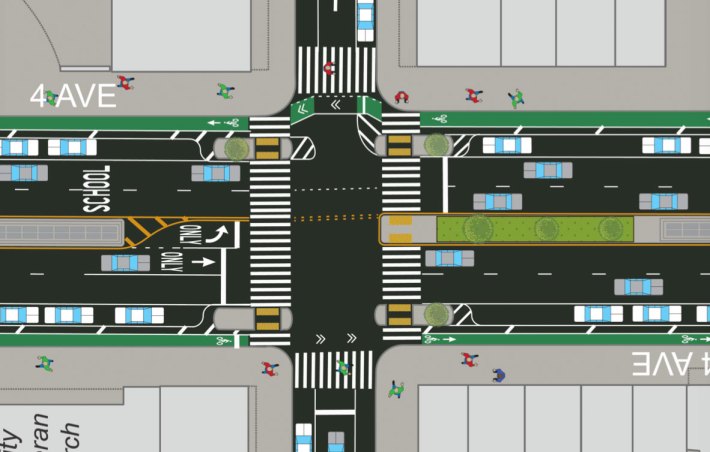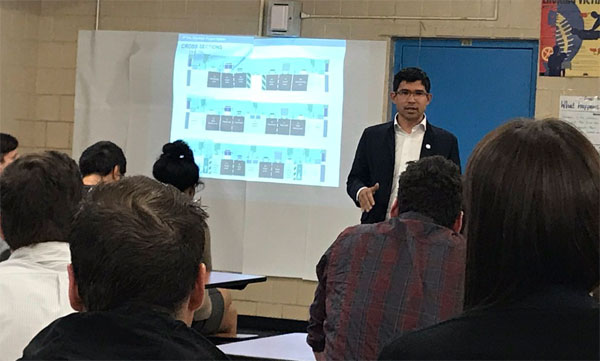DOT reps brought the conceptual design for a redesign of Fourth Avenue with protected bike lanes to Sunset Park last night, following a similar event in Park Slope last week.
A DOT road diet for Fourth Avenue implemented in 2012 and 2013 removed a motor vehicle lane in each direction while widening pedestrian medians, bringing traffic crashes and injuries down. Last year, with the city gearing up for a top-to-bottom reconstruction that would cast the improvements in concrete, Council Member Carlos Menchaca prevailed on DOT to consider adding protected bike lanes to the plan. DOT is now showing that concept in public forums, in preparation for detailed design work.
Last night's event drew a crowd of around 60 people, but some Sunset Park communities, including the neighborhood's non-English-speaking residents, were underrepresented. Elizabeth Yeampierre, the executive director of neighborhood environmental justice group UPROSE, said the city needs to do a better job of including people.
“My concern about this gathering is that it doesn’t represent a cross-section of this community, or the majority of the people who live neighborhood," Yeampierre said at the start. "I'm concerned that the recommendations that come of this space are not going to reflect the priorities of the people impacted by this corridor."
Fourth Avenue plays an important role in the cultural and commercial life of Sunset Park, with a number of schools, businesses, and places of worship lining its sidewalks. Speaking last night, Menchaca called on DOT to ensure that families with children, small businesses, and immigrant communities are included in the process moving forward.
DOT Bicycle Program Director Ted Wright committed to working with UPROSE and other groups to involve the entire neighborhood. "We want to get out there, we want to talk to as many people as possible," Wright said. "We usually just go through the community boards and use the community boards. This is above and beyond."

Instead of extra-wide medians, the revised concept calls for four pedestrian islands at typical intersections. Those islands will narrow some crossings more than the original plan, improve sight lines so drivers can better see crossing pedestrians, calm turning traffic, and improve safety for cyclists at intersections.
In general, that aspect of the new redesign concept is likely to reduce crashes and injuries more than the current configuration. The islands will also replace parking spaces, which figures to be a point of contention moving forward.
"We need better bikeways across the city, especially connecting [north-south] -- Fifth Avenue is a mess, Fourth Avenue needs to be a bikeway," said Sara Greenfield, who lives at 47th Street and Fifth Avenue. But, she said, "it's going to be a hard sell for some small businesses and a lot of drivers."
Greenfield bikes to work in Park Slope via Fifth Avenue, which has unprotected bike lanes that are often blocked by double-parking. She said the ride doesn't feel safe. "Fourth Avenue would be a huge bonus, and I think it will help pedestrians a ton," she said. "It will slow traffic down and it'll allow a much safer crossing."
"There are some gives and takes in everything that we do. We can't do everything," Menchaca told the room. "The pedestrian experience across Fourth Avenue is so important. We have schools, we have businesses, we have residents, and we have a corridor that has MTA train stations. There’s a lot of activity here. And the bike lane is an important part of the conversation because it provides that corridor and connection."






